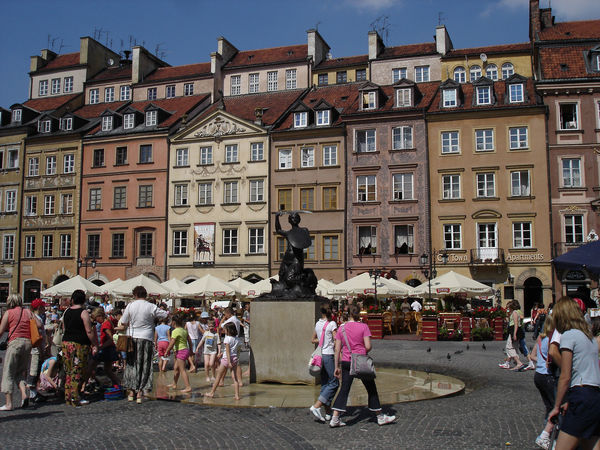Warsaw, Resilient and Reborn
By Rick Steves

Warsaw doesn't appear at the top of many European travelers' wish lists. But that's just one reason you may want to visit. With evocative sights, an epic history, and low prices, Warsaw is a diamond in the rough.
Warsaw is both the national capital and the country's cosmopolitan business hub. Varsovians (as locals are called) are chic and sophisticated — and Varsovian by choice: According to some studies, as many as 8 out of every 10 Varsovians weren't born in Warsaw. Today's Warsaw has gleaming office towers, swarms of international businesspeople, inviting parks and pedestrian zones, and a hipster culture to rival Brooklyn's or Portland's. For cobbled medieval charm Polish-style, head to Kraków and Gdańsk. But to look modern-day Poland frankly (but no less enjoyably) in the face, make time for Warsaw.
Warsaw has good reason to be so forward-looking: Its past has been hard. Since becoming Poland's capital in 1596, it has seen wave after wave of foreign rulers and invasions.
Warsaw's darkest days came during the Nazi occupation of World War II. First, its Jewish residents were forced into a tiny ghetto. They rose up…and were slaughtered. Then, its Polish residents rose up…and were slaughtered. In retaliation, Hitler ordered the block-by-block destruction of the city.
As the smoke cleared and the Nazis retreated, the Soviets marched in and claimed the pile of rubble that had once been Warsaw. It would be another 45 years before the Soviets would leave and the Poles could freely govern their capital and their country. But in this horrific crucible, the enduring spirit of the Polish people was forged.
After the war the Poles almost gave up on re-creating old Warsaw, but ultimately they decided to rebuild, constructing a city of contrasts. Now, painstakingly restored medieval lanes border pedestrian-friendly parks and sleek skyscrapers. As one proud resident told me, "Warsaw is ugly because its history is so beautiful."
Today's Warsaw is safer, wealthier, and happier than ever. Visitors encounter stylishly dressed locals, sophisticated shopping boulevards, and thoughtful museums covering World War II, Jewish history, hometown composer Frédéric Chopin, and Polish art.
The city has two historic districts: the 13th-century Old Town and the 15th-century New Town. Both are nearly complete 20th-century reconstructions, right down to the higgledy-piggledy charm of the colorful buildings.
The countless restaurants in the historic district provide a good introduction to Polish cuisine — and the national drink, vodka. Many traditional dishes — herring, cold cuts, pickles, steak tartare — pair naturally with chilled vodka. And as any local will be quick to show you, Poles don't sip their vodka — it's a bottoms-up drink ("that way it only stings once").
For me, the pleasure of Warsaw is just connecting with its big-city people, who are as warm and charming as small-town folk. I've found that Poles generally love Americans — they tend to think of us as brothers and sisters from across the Atlantic. In 1989, when the communist government gave Poles a shot at representative government, the "get out the vote" poster showed Gary Cooper from High Noon — holding not a gun, but a voting card.
Remnants of Warsaw's earlier magnificence show up in huge, idyllic Łazienki Park. It's sprinkled with Neoclassical buildings, peacocks, and young Poles in love. Poland's very last king built the park in the 18th century for his summer residence and as a place for his citizens to relax.
A monument to Chopin, Poland's great Romantic composer and favorite son, graces the park's rose garden. Even though Chopin left Warsaw for Paris, his final wish was to have his heart brought back to his native Poland. And so it was, after his death in 1849. It now lies buried in a pillar in Warsaw's Holy Cross Church (the rest of him is interred at Paris' Père Lachaise Cemetery).
Varsovians still proudly celebrate the music of this hometown hero. On summer Sundays, happy crowds fill Łazienki Park for Chopin concerts held in front of his statue; smaller performances are common all across the city. When I was last in town, I attended an intimate salon-style concert at a hotel. The pianist, seated at a baby grand under a lovingly lit portrait of the composer, closed his eyes as if to channel all this heart into his fingers as they flew across the keys. I could sense the entire audience swooning, as I was, in the same moment.
Long before recorded sound was even imaginable, music lovers across Europe gathered to hear the latest and greatest tunes by attending performances just like this one. It felt so appropriate to fall under the spell of Chopin, up close and personal, among resilient, culture-loving Poles right here in the middle of Warsaw, a city that refuses to die.

